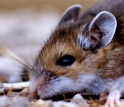|

Press Release 06-105
Increased Risk of Hantavirus Forecast for U.S. Southwest

Satellite images of ecological conditions help predictions
July 12, 2006
The Four Corners region of the United States (where Ariz., N.M., Colo. and Utah meet) will be at greater risk for hantavirus outbreak this year than in 2005, say scientists at Johns Hopkins University, the University of New Mexico, and other institutions.
They also warn that parts of southern Colo. and north-central N.M.--previously at low-risk for hantavirus compared to the Four Corners region--are at increased risk in 2006.
The study is among the first to forecast the location and extent of an infectious disease outbreak.
The forecast, based on research funded by the joint National Science Foundation (NSF)-National Institutes of Health (NIH) Ecology of Infectious Disease (EID) Program, is based on an analysis of satellite imagery and is published in the July 12, 2006, edition of the journal Occasional Papers, Museum of Texas Tech University.
"The causes of hantavirus outbreaks are complex," said Sam Scheiner, NSF program director for EID. "This study demonstrates that ecological research can lead to a better understanding of the complex factors in hantavirus outbreaks, and in predictions that result in saving human lives."
Hantavirus pulmonary syndrome is a rare but deadly respiratory disease caused by exposure to a variety of hantaviruses. People contract the virus through contact with rodents and rodent droppings. In 2005, the Four Corners region recorded four cases of hantavirus.
The researchers forecast the hantavirus risk in 2006 as "moderate," similar in severity to the six and eight cases recorded in region in 1998 and 1999 respectively.
"The conditions in the Four Corners region tell us that there is a greater risk for hantavirus this year compared to last year," said Gregory Glass of John Hopkins University, the study's lead author. "Through this research, we've found that satellite imagery can be used to identify the location and extent of infectious diseases spread by animals."
To forecast the risk of hantavirus, Glass and other scientists examined satellite images of the Four Corners region taken in 2005. The images provided information on vegetation growth, soil moisture and other ecological conditions, which Glass and his colleagues previously determined were where mice and hantavirus thrived.
They then calculated the level of risk for the region and for specific areas within the region in 2006. The researchers verified the accuracy of their forecast model by comparing their forecasts with actual hantavirus outbreaks going back to 1993, when the disease was first identified in the United States.
Their forecasts, based on data from 1993, 1997 and 1998, accurately predicted the actual disease outbreaks for 1994, 1998 and 1999 respectively.
Co-authors of the paper are: Timothy Shields of Johns Hopkins University; Robert Parmenter of the Valles Caldera National Preserve in Los Alamos, N.M.; Diane Goade, Joseph Cook and Terry Yates of the University of New Mexico; James Mills of the Centers for Disease Control and Prevention (CDCP); and James Cheek of the Indian Health Service, Albuquerque, N.M.
The research was also funded by NASA and the CDCP.
-NSF-

Media Contacts
Cheryl Dybas, NSF (703) 292-7734 cdybas@nsf.gov
Tim Parsons, JHU (410) 955-6878 paffairs@jshph.edu
Related Websites
NSF Special Report: Ecology of Infectious Diseases: http://www.nsf.gov/news/special_reports/ecoinf/solved.jsp

The National Science Foundation (NSF) is an independent federal agency that supports fundamental research and education across all fields of science and engineering. In fiscal year (FY) 2009, its budget is $9.5 billion, which includes $3.0 billion provided through the American Recovery and Reinvestment Act. NSF funds reach all 50 states through grants to over 1,900 universities and institutions. Each year, NSF receives about 44,400 competitive requests for funding, and makes over 11,500 new funding awards. NSF also awards over $400 million in professional and service contracts yearly.
 Get News Updates by Email Get News Updates by Email
Useful NSF Web Sites:
NSF Home Page: http://www.nsf.gov
NSF News: http://www.nsf.gov/news/
For the News Media: http://www.nsf.gov/news/newsroom.jsp
Science and Engineering Statistics: http://www.nsf.gov/statistics/
Awards Searches: http://www.nsf.gov/awardsearch/
| 


